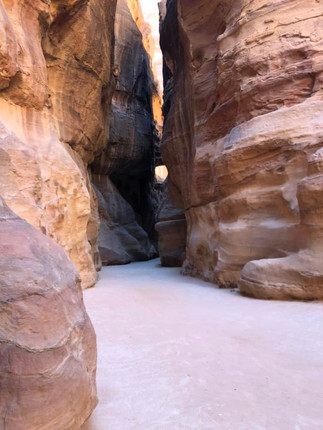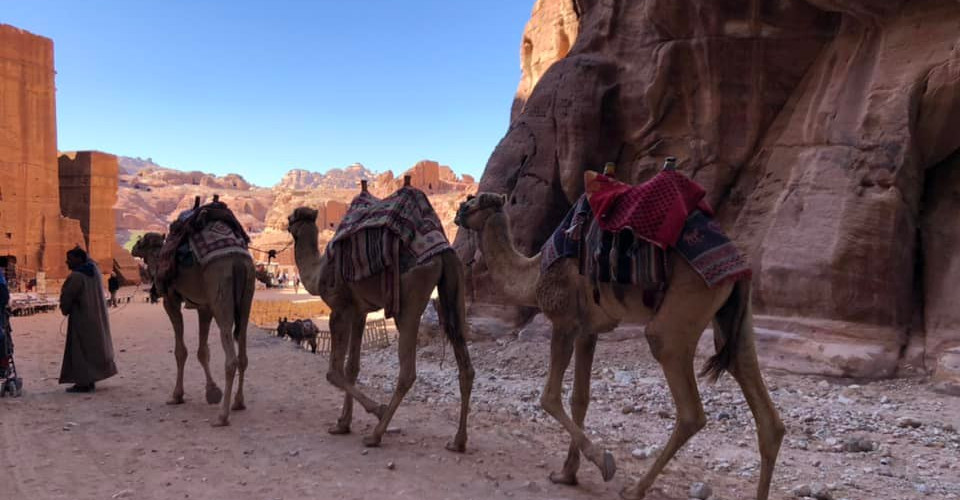A Magic Carpet Ride
- Teryn
- Mar 12, 2022
- 10 min read

Petra is located about 1.5 hours north of Wadi Rum, along the Kings Highway and the Desert Highway. The red sands of the desert have now been replaced with a barren moon-like terrain of rolling hills and mountains. Tourist-focused shops along the way all boast signs claiming to have the "best view in the world", or even "the second best view in the world". But in fact, they all have about the same view - worth a photo or two, but that's about it. Many of the towns in this part of the country are nestled on hillsides, and Petra, or more accurately, Wadi Musa, was no exception.
Petra is actually a once hidden gem tucked away deep within the mountains, unseen and unknown to most people save from the Bedouins who occupied it. It was re-discovered and once again brought to the eyes of the world by Swiss explorer Jean Louis Burckhardt in 1812, who had to sneak his way in by pretending to be a Holy man. It's now accessible to the world using Wadi Musa as a base, and paying a hefty entry fee of 50 JOD or 55 JOD for 2 days (around $100 CDN).
We set up camp at La Maison hotel and quickly made our way down to the entrance of Petra. (No, not an actual camp, but rather a modern hotel with a glorious rainfall shower). Petra was one of the places I'd been most looking forward to on this trip. The Treasury, one of the New 7 Wonders of the World, is a place that's always been on my bucket list. Ever since I first saw it on Departures back in my 20's, I've longed to experience the wonder of its first glimpse... watching it appear into view as the narrow siq walls open to reveal its grandeur. I was so excited, and like most people I wanted to rush in, bypassing everything leading up to it. Thankfully, I didn't.
From the visitor centre you walk down a long, winding hill (horses on the left, people on the right - see photo below), to an old dam, then enter the siq.

The siq, which is a 1.2km long split rock, is a beauty all on its own. Although it looks like a canyon, as you walk along the path with rock walls upwards of 200 metres high looming on either side of you, it's actually not. Having at one time been a solid rock, tectonic forces have since forced the rock apart. It hasn't been worn away by water, like occurs with canyons. In places you can even see where one side matches the other (although granted time has also worn away the exact jigsaw nature of the faces). Yet despite time, the history still remains. Centuries-old carvings of camels and caravan leaders can be seen etched into the walls, just as idols of deities can also be found. The advanced engineering of life before can still be seen. There are aqueducts, old systems of terracotta water pipes still deep within the walls, the dam that holds back water from flooding the cities, tombs erected to honour those who have passed on, and the creation of temples and pathways that lay disguised throughout.
But then the walls start to close in, at times only two metres wide. Your anticipation builds as you go around each corner thinking "this is it! this is it!" Finally, there it is. You look up and see a single column. So delicately and remarkably carved. You know so much more is there, attached to this hand-carved masterpiece. It's taunting you, making you want more. But as you walk a few more steps it fades from view. So you take a few more...

And there it is.
In all its glory.
The Treasury.

It's even more stunning that you imagined it to be. The size. The detail. The grandeur. You look past the crowd of people taking selfies, the Bedouin urging you to come with them for an even better view from above, the tourist shops selling scarves and trinkets. It all fades out as you take it all in. You notice the gunshot holes covering some of the statue carvings near the top, where people once thought true the tale that a treasure existed, hidden inside. You see how the whole facade represents a calendar - the 12 pillars for the 12 months, the 7 glasses for the 7 days of the week, the 365 notches on the sides representing each day of the year. It's amazing. Stunning. Everything I imagined it to be and so much more. It's hard to take it all in. There's just so much.
But much more to my surprise, Petra is so much more than the Treasury. There's an entire city beyond this facade. There's the theatre, the high place of sacrifice, the street of facades, the churches, the temples, the living quarters, the monastery, the basin... There's no way you can see it all in a day. Petra is in no way a day trip or a place you can quickly pass by. Just the main trail, in and of itself, is more than 8km long, round trip. It was all we could accomplish today. A quick overview of Petra, slowed down by the many urgings of vendors berating you with the same 3 phrases: "Have a look", "it's free to look", "___fill in the blank item____ only 1 dinar". A simple "no thank-you" or "la shukran" usually does the trick, but some will continue on, presumably in correspondence to how business has been for them that day.
(Swipe for a slide show of Petra)

After emerging from the siq, tired and trudging along on weary legs, a few of us ducked off into "The Cave". As we sat in The Cave, which holds claim to being the world's oldest bar, set in a 2000 year old Nabataean rock tomb, we cheers'd to a solid day of discovery over $15 CDN Jordanian beers. Being that Jordan is mostly a dry country, following Islamic practices, alcohol is reportedly only available in 3 select places: certain venues in Amman, Madaba, and "The Cave" in Wadi Musa. We figured we should try at least one pint, but with it's high price point, just one. It was, unsurprisingly, called "Petra", and really just tasted like a Pilsner. But since we hadn't had a drink all trip, it was a nice treat.
Later that evening we all celebrated Reuben's birthday, the young Irish lad on our trip who had just turned 14. Big moment for him. We even got him off of You Tube long enough to enjoy cake and a boisterous Jordanian version of Happy Birthday. Ignoring the cost, we popped back over to The Cave for a post-dinner night cap. Turns out The Cave has an exotic night ambience and Amstel is a better Jordanian beer than Petra. But morning comes early, and the 6:00am wake-up call was rough.

Most of us had opted to venture off to Little Petra and hike the back entrance into Petra to kick off day two. And despite the early morning, no regrets were had. There's an extensive trail route here called "The Jordan Trail." It's a 45(ish) day hike from the north of the country to the south. THere's a popular 5 day stretch that's touted by National Geographic as one of the top 15 hikes in the world. The back entrance into Petra is day 4 of 5 of that hike, and I can see why. It's amazing. The views, although barren and monochrome at times, are crazy. It's not a difficult trek, but it's got a few ups and downs that get the blood flowing. It's a fairly unmarked trail and at times easy to accidentally head the wrong direction (we had to set a group of mis-guided hikers back on track on one occasion). But the positives outweighs the necessary recommendation of a guide - there are VERY few other people (one lone tea shop owner said he gets about 10 tourists/day in February), you avoid a full one way trip past NUMEROUS vendors on a 800+ stair climb up to the monastery, instead enjoying a scenic one way route, rather than an out and back (or rather, up and down).
(Swipe for a slide show of the back entrance into Petra)
We passed the time playing "draft", a great little game of who can come up with the best list of something, depending on the topic. - like, best snack foods, for example (which I won - popcorn, chips, veggies and dip, and pita with guac. Argue me on that one.. I dare you). At the end, we were further rewarded with a delicious Arabic coffee (strong coffee with cardamom), and a lunch of pita bread and tetra pack hummus, from a previous grocery store run. (Also tetra pack hummus is the greatest thing ever. Who doesn't want hummus on the fly without having to worry about refrigeration?!)
We sat at a tea shop overlooking the monastery. Similar in nature to the treasury, but bigger, it just didn't hold the same sense of awe. Shortly after we began our descent down the rock steps (many hundreds of them), watching poor donkeys carry up those tourists that either don't want, or are unable, to do the climb on their own. I understand wanting to see the monastery and not being able to physically do it on your own, so you opt to utilize the donkey. BUT, if you CAN do it, please do it. The animals in Petra are not always treated as humanely as they should be.
Many (donkeys, horses, and camels included), are hit, shoved, or forced to carry way more than they probably should. In fact, it was such a problem that an organization was actually set up for tourists to report any ill treatment of animals in Petra. And though some are treated respectfully, I personally witnessed many who were not - having been hit, smacked, or yelled at. It's one of those things. Just because you CAN do something, doesn't mean you always SHOULD. There's also the option to take a horse from the Petra visitor centre down the trail to the start of the siq, which is probably less than 1km. The horse handlers will try to get you on their horses by reminding you, incessantly, that it's included in your ticket prices... which it is, but if you do go to Petra, try not to do it. Even our local guide (and Lonely Planet) advised against it due to the poor treatment of animals. But I digress...
Once we had descended the monastery trail we broke off into smaller groups. B and I decided to forego lunch and attack Al-Khubtha straight away. It's rated on the trail guide as hard, requiring 2.5-3 hours to complete the 4.5km round trip.
Challenge accepted.

We stumbled around trying to find the trail head, but once we did we put our heads down and began the ascent. The trail starts at one side of the Street of Facades, and takes you relentlessly up and behind the facades. Eventually you reach the top-most point of a mountain where you find a quaint little tea shop set up in a cave of rocks, overlooking the treasury. Sans guard rail. It's a bit nerve-racking standing at the edge of a cliff, in a tea cave, but this is also the spot for the coveted "magic carpet ride" photos. We happened to get up there around noon, and the lighting was absolutely perfect. There were also very few other people there, save for one Mexican-Argentinean couple we met along our hike up. We stood, savouring the views for awhile, but still having a long day ahead of us, made our way back, high-fiving the rest of our group as we passed each other on the way down.
We finished Al-Khubtha in record time - 1 hour 15 minutes - and heavily debated attempting "The High Place of Sacrifice", a 4km long trail that was estimated to take 3.5-4 hours to complete. However, we had our hearts set on going for a hammam before coming back for Petra at Night, so decided against it due to time constraints.
If you've never been for a hammam before, or maybe don't even know what it is, let me tell you all about this glorious experience you must do, at least once in your life. Hammam, or Turkish bath, is essentially a communal bath house. Now, depending on the style you go to - from a more local neighbourhood hammam to a fancy tourist one, the experience may be slightly different. But essentially it looks like this: there are separate sides for men and women, but I'm told the men's experience is very similar. You strip down to your birthday suit or your undies (depending on your level of comfort and venue requirements), are given/use your own hammam towel (like a thin, scarf-like piece of linen) to cover yourself. You are then shown to the steam room. A large room that has either a big marble slab in the middle, just benches, or nothing at all (depending on style). Then you take off the towel and relax for the next 15 or so minutes, just letting that steam work its magic as you sweat it all out and open those pores. An attendant of the same sex will then come and get you and bring you to a new room. The washing room. (I've had everything from a tile floor, to a marble slab table, to an entirely marble room with marble seats against the wall.) The attendant will then take a course scrubbing mitt or cloth and scrub you from head to toe in every nook and cranny to remove all the dead skin. Then you get a quick rinse followed by a long soapy wash and sometimes a massage. If you're lucky, you may even be sung to. The washing room is also a communal room with one attendant per person, so can be quite busy. But if you're lucky, you'll have it all to yourself. It's a bit of an awkward and intimate experience to have a stranger washing you, but once you're all rinsed off, you'll forget all about it due to how refreshed and amazing you feel. I promise, your skin will have never felt so soft. It's incredible. You MUST do it! I felt like a new woman after my afternoon hammam. Refreshed, relaxed, just great.

Later that evening we went out to see Petra at night. Three times per week, paper bag lanterns line the entire route from visitor centre to Treasury. There are no pushy vendors and quiet music plays as you walk through the siq. In theory it should be a magical experience enjoyed in silence, but nobody follows rules these days. There's a low roar of people talking, the occasional child screaming or laughing, and people yelling out to others in their group. It is, however, incredible to see the entire sandy base of the Treasury lit up in candlelight, and the glow of the moon illuminating the basin. You then sit on carpets, sip tea, listen to some traditional music and a story, then gaze upon a rainbow display of light on the treasury. It's maybe not work the 17 JOD, but I do recommend it for the experience if it's in your budget. Plus, you may get the extra addition of seeing "ab guy" - a probable instagrammer who brings specific self-lighting, unbuttons his shirt, then proceeds to have his own disrespectful photoshoot in front of this ancient UNESCO heritage site. Or maybe it was just us who were so lucky.
Even with ab guy, Petra has been my favourite place in Jordan thus far. There's so much to see, do, and endless hiking opportunities. I guess there's even an annual Petra desert marathon! Plus, anywhere there's a hammam or a 2000 year old cave bar is a win in my book.
But the Dead Sea is up next, so let's see if Petra can hold it's own over that historical gem.





























































































Comments